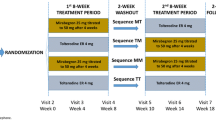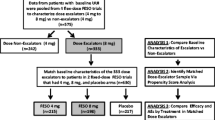Abstract
Objective: This double-blind, multinational study was performed to further evaluate the efficacy of tolterodine, a new bladder-selective antimuscarinic agent, for reducing urge incontinence episodes and other urinary symptoms in patients with overactive bladder.
Patients and Methods: 1022 patients with urge incontinence (≥5 episodes/week) and urinary frequency (≥8 micturitions/24 hours) were randomised to treatment with tolterodine 2mg twice daily (n = 514) or placebo (n = 508). Changes in micturition diary variables were evaluated after 12 weeks’ treatment. Tolerability end-points, and patients’ perceptions of their bladder condition, urgency and treatment benefit, were also determined.
Results: Tolterodine 2mg twice daily reduced urge incontinence episodes by 46% versus baseline, and this decrease was significant compared with the change with placebo (p = 0.0005). Significant decreases from baseline were also observed for micturition frequency (−15%) and pad usage (−36%) compared with placebo (p < 0.01 for both comparisons), while there was a significant increase from baseline in volume voided per micturition (+21%) compared with placebo (p = 0.0001). These changes were meaningful to tolterodine-treated patients; a greater proportion of patients on tolterodine reported less severe urgency and had improvements in their bladder condition than placebo recipients, while 40% perceived ‘much benefit’ from treatment (22% on placebo, p < 0.001). Withdrawals were essentially the same between the two treatment groups. No clinically relevant changes in blood pressure or laboratory parameters were observed.
Conclusions: Tolterodine 2mg twice daily is effective against all the troublesome symptoms of overactive bladder and these effects are meaningful to patients. Tolterodine was well tolerated.







Similar content being viewed by others
References
Jackson S. The patient with overactive bladder —symptoms and quality of life issues. Urology 1997; 50(6ASuppl.): 18–22
Johannesson M, O’Connor RM, Kobelt G, et al. Willingness to pay for reduced incontinence symptoms. Br J Urol 1997; 80: 557–62
Kobelt G, Kirchberger I, Malone-Lee J. Review. Quality-of-life aspects of the overactive bladder and the effect of treatment with tolterodine. BJU Int 1999; 83: 583–90
Wein AJ, Rovner ES. The overactive bladder: an overview for primary care health providers. Int J Fertil Womens Med 1999; 44: 56–66
Andersson K-E. Current concepts in the treatment of disorders of micturition. Drugs 1988; 35: 477–94
Andersson K-E. The overactive bladder: pharmacologic basis of drug treatment. Urology 1997; 50(6A Suppl.): 74–84
Yarker Y, Goa KL, Fitton A. Oxybutynin: a review of its pharmacodynamic and pharmacokinetic properties, and its therapeutic use in detrusor instability. Drugs Aging 1995; 6: 243–62
Drutz H, Appell RA, Gleason D, et al. Clinical efficacy and safety of tolterodine compared to oxybutynin and placebo in patients with overactive bladder. Int Urogynecol J Pelvic Floor Dysfunct 1999; 10: 283–9
Katz IR, Sands LP, Bilker W, et al. Identification of medications that cause cognitive impairment in older people: the case of oxybutynin chloride. J Am Geriatr Soc 1998; 46: 8–13
Nilvebrant L, Anderson K-E, Gillberg P-G, et al. Tolterodine —a new bladder-selective antimuscarinic agent. Eur J Pharmacol 1997; 327: 195–207
Nilvebrant L, Hallén B, Larsson G. Tolterodine —a new bladder selective muscarinic receptor antagonist: preclinical pharmacological and clinical data. Life Sci 1997; 60: 1129–36
Stahl MMS, Eckström B, Sparf A, et al. Urodynamic and other effects of tolterodine: a novel antimuscarinic drug for the treatment of detrusor overactivity. Neurourol Urodyn 1995; 14: 647–55
Appell RA. Clinical efficacy and safety of tolterodine in the treatment of overactive bladder: a pooled analysis. Urology 1997; 50(6A Suppl.): 90–6
Abrams P, Freeman R, Anderström C, et al. Tolterodine, a new antimuscarinic agent: as effective but better tolerated than oxybutynin in patients with an overactive bladder. Br J Urol 1998; 81: 801–10
Atan A, Konety BR, Erickson JR, et al. Tolterodine for over-active bladder: time to onset of action, preferred dosage, and 9-month follow-up. Tech Urol 1999; 5: 67–70
Wein AJ, Abrams P, Appell R, et al. Tolterodine is effective and well tolerated during long-term use in patients with over-active bladder [abstract]. J Urol 1999; 161 Suppl.: 35
Zorzitto ML, Holliday PJ, Jewett MA, et al. Oxybutynin chloride for geriatric urinary dysfunction: a double-blind placebo-controlled study. Age Ageing 1989; 18: 195–200
Norton P, Karram M, Wall LL, et al. Randomized, double blind trial of terodiline in the treatment of urge incontinence in women. Obstet Gynecol 1994; 84: 386–91
Jonas U, Höfner K, Madersbacher H, et al. Efficacy and safety of two doses of tolterodine versus placebo in patients with detrusor overactivity and symptoms of frequency, urge incontinence, and urgency: urodynamic evaluation. World J Urol 1997; 15: 144–51
Rentzhog L, Stanton SL, Cardozo L, et al. Efficacy and safety of tolterodine in patients with detrusor instability: a dose-ranging study. Br J Urol 1998; 81: 42–8
Van Kerrebroeck PEVA, Amarenco G, Thüroff JW, et al. Dose-ranging study of tolterodine in patients with detrusor hyperreflexia. Neurourol Urodyn 1998; 17: 499–512
Larsson G, Hallén B, Nilvebrant L. Tolterodine in the treatment of overactive bladder: analysis of the pooled phase II efficacy and safety data. Urology 1999; 53: 990–8
Millard R, Tuttle J, Moore K, et al. Clinical efficacy and safety of tolterodine compared to placebo in detrusor overactivity. J Urol 1999; 161: 1551–5
Anderson RU, Mobley D, Blank B, et al. Once daily controlled versus immediate release oxybutynin chloride for urge urinary incontinence. OROS Oxybutynin Study Group. J Urol 1999; 161: 1809–12
Meyhoff HH, Gerstenberg TC, Nordling J. Placebo —the drug of choice in female motor urge incontinence? Br J Urol 1983; 55: 34–7
Ouslander JG, Blaustein J, Connor A, et al. Pharmacokinetics and clinical effects of oxybutynin in geriatric patients. J Urol 1988; 140: 47–50
Thüroff J, Bunke B, Ebner A, et al. Randomized, double-blind, multicentre trial on treatment of frequency, urgency, and incontinence related to detrusor hyperreactivity: oxybutynin versus propantheline versus placebo. J Urol 1991; 145: 813–17
Abrams P, Larsson G, Chapple C, et al. Factors involved in the success of antimuscarinic treatment. Br J Urol 1999; 83Suppl. 2: 42–7
Frewen W. Role of bladder retraining in the treatment of unstable bladder in the female. Urol Clin North Am 1979; 6: 273–7
Kelleher CJ, Cardozo LD, Khullar V, et al. A medium term analysis of the subjective efficacy of treatment for women with detrusor instability and low bladder compliance. Br J Obstet Gynaecol 1997; 104: 988–93
Acknowledgements
This study was supported by Pharmacia & Upjohn.
Author information
Authors and Affiliations
Corresponding author
Rights and permissions
About this article
Cite this article
Chancellor, M., Freedman, S., Mitcheson, H. et al. Tolterodine, an Effective and Well Tolerated Treatment for Urge Incontinence and Other Overactive Bladder Symptoms. Clin. Drug Investig. 19, 83–91 (2000). https://doi.org/10.2165/00044011-200019020-00001
Published:
Issue Date:
DOI: https://doi.org/10.2165/00044011-200019020-00001




